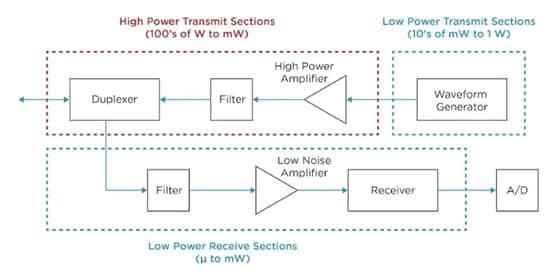This article based on Knowles Precision Devices blog explains the role of Couplers, Combiners, and Dividers in radar power amplifiers.
At the most basic level, high-power amplifiers (HPAs) take signals from the waveform generator and increase the signal level to a higher power as shown in Figure 1.
Depending on the system, the increase could take the signal from hundreds of watts to many megawatts. This is an essential step for many radar systems to boost the strength of a signal and improve range, resolution, and overall performance.
HPAs have actually existed for quite some time. For example, PAVE PAWS, which was an early warning radar system, and the first all-solid-state active electronically steered array (AESA), was developed in the 1970s, It had a transmit power of 340W per T/R module, but summed over 1,792 modules, the signal ended up at over 500 kW. However, the efficiency and reliability of PAs has continued to improve over the years as technologies have advanced.
An Overview of Solid-State Power Amplifiers
For many RF applications, PAs are based on traveling wave tube (TWT) technology, which uses electron beams in a vacuum to achieve high power levels. However, this type of PA can be quite heavy, large, and inefficient, making it challenging to use in size-constrained environments or when precision is required.
Instead, solid-state power amplifiers (SSPAs), which are based on modern semiconductor devices like transistors developed with GaN or GaAs, are generally smaller, lighter, more compact, and offer higher reliability. Therefore, SSPAs can be used to maximize system performance in applications where size, efficiency, and reliability are critical such as satellite communications or many radar systems.
To achieve a higher overall power output efficiently, SSPAs are typically designed using power summation over a series of modules, which provides a graceful degradation capability not found with TWTs. Thus, a basic building block of many all-solid-state HPAs is the PA module (Figure 2).
In the example shown in Figure 3, the input to the HPA is split four ways and passed through four PA modules. Then, the amplified output from each PA module is combined with a four-way combiner.
The Role of Couplers, Combiners, and Dividers in the SSPA
When it is necessary to deliver a high level of output power to the antenna, power combiners and dividers are key components needed in the transmitters. Let’s take a closer look at how these components function.
RF power dividers are designed to split an incoming signal into multiple outputs such that there’s a portion of the original signal’s power in each output. These signals are then fed into multiple amplifiers, where each module amplifies a portion of the signal, making it possible to achieve a higher overall power level when the output of the modules is combined again. This is where the power combiners come in, bringing the split signal back into single high-power RF signal that is then transmitted through the radar’s antenna.
Couplers, such as quadrature hybrid couplers, can be used to perform the power splitting or combining while providing improved input match for unbalanced loads. Using a quadrature hybrid coupler for these functions can offer many benefits such as balanced amplification, enhanced signal linearity, and isolation between amplifier modules, which will lead to more efficient and stable RF systems.
